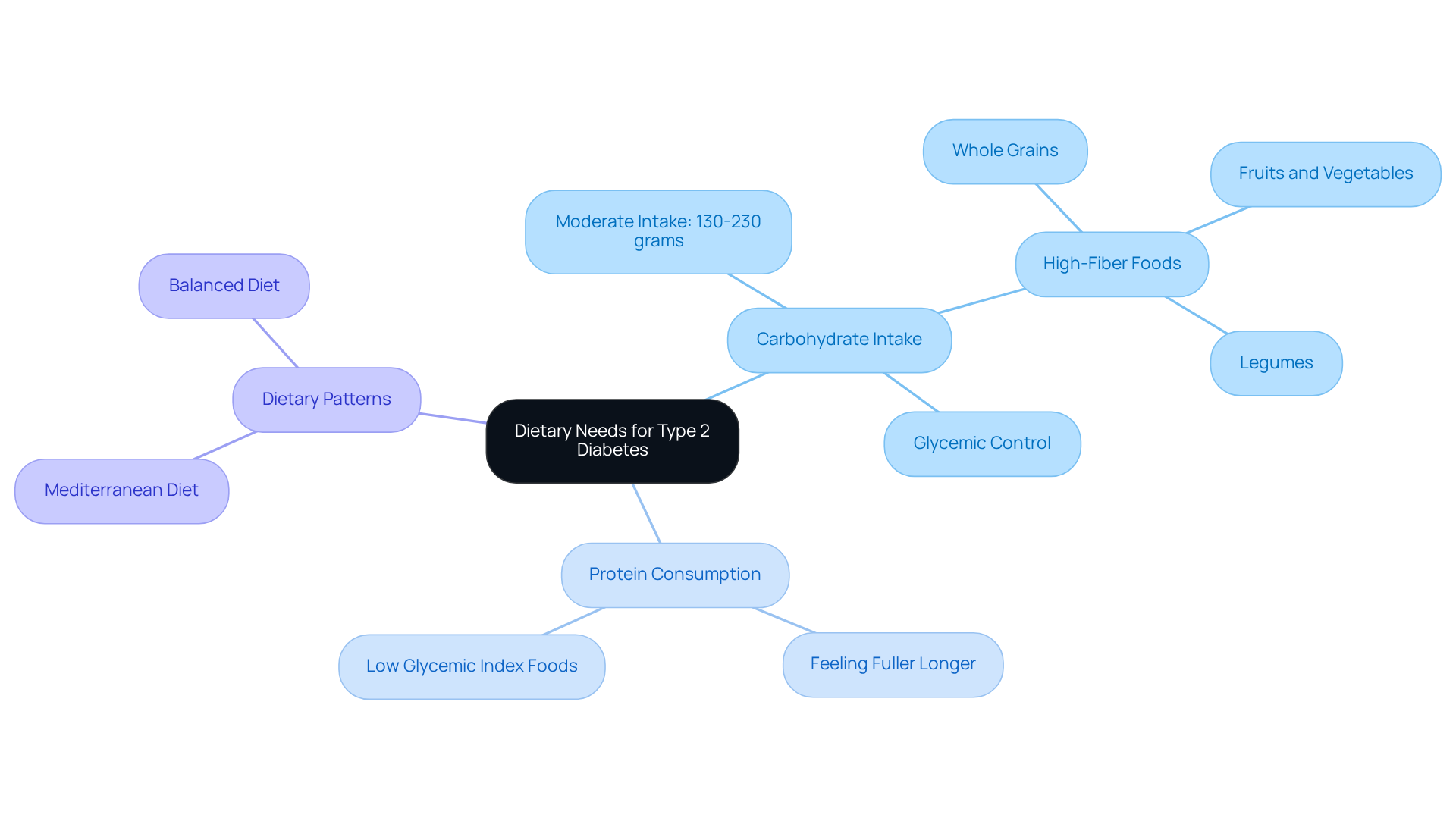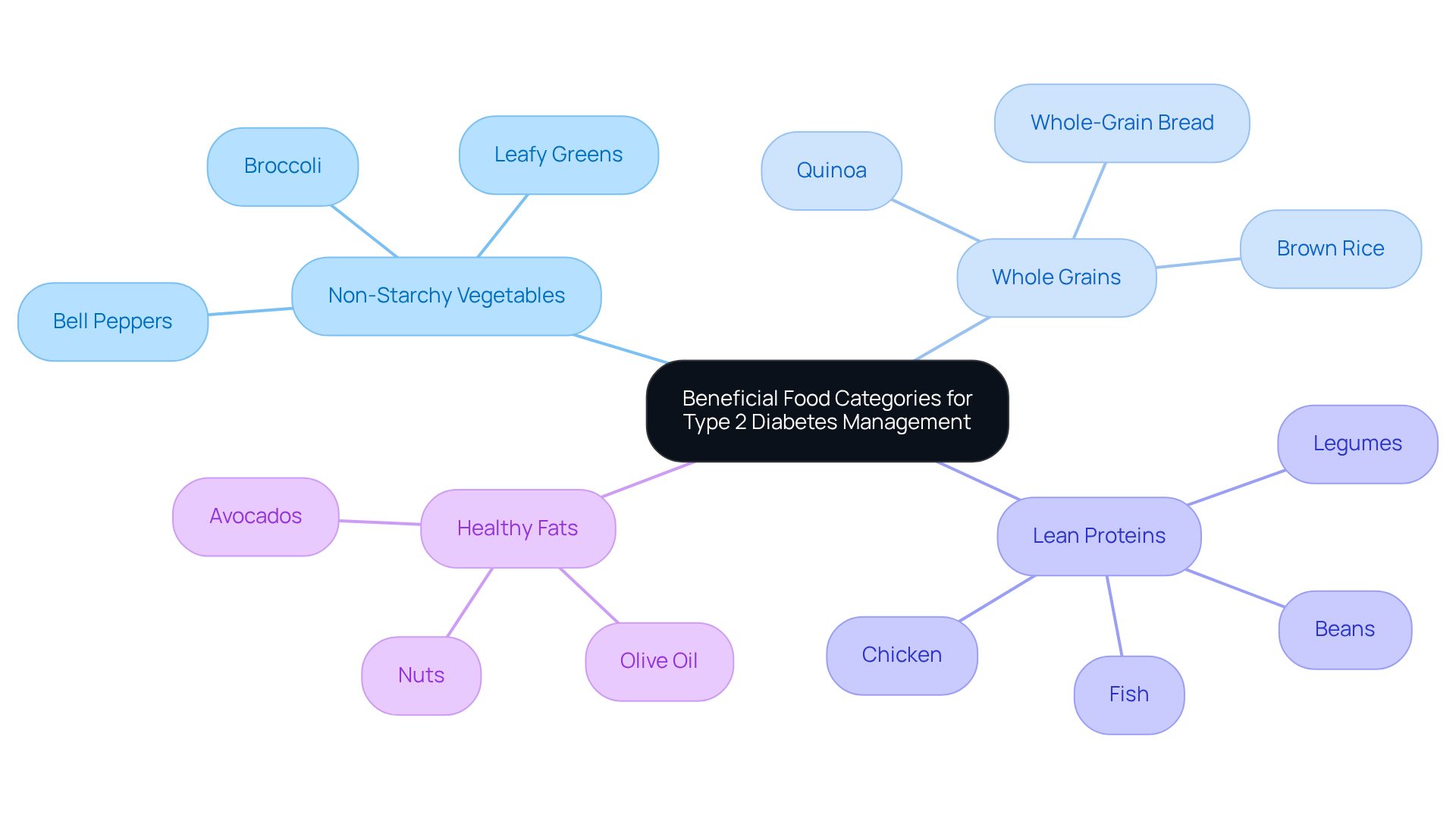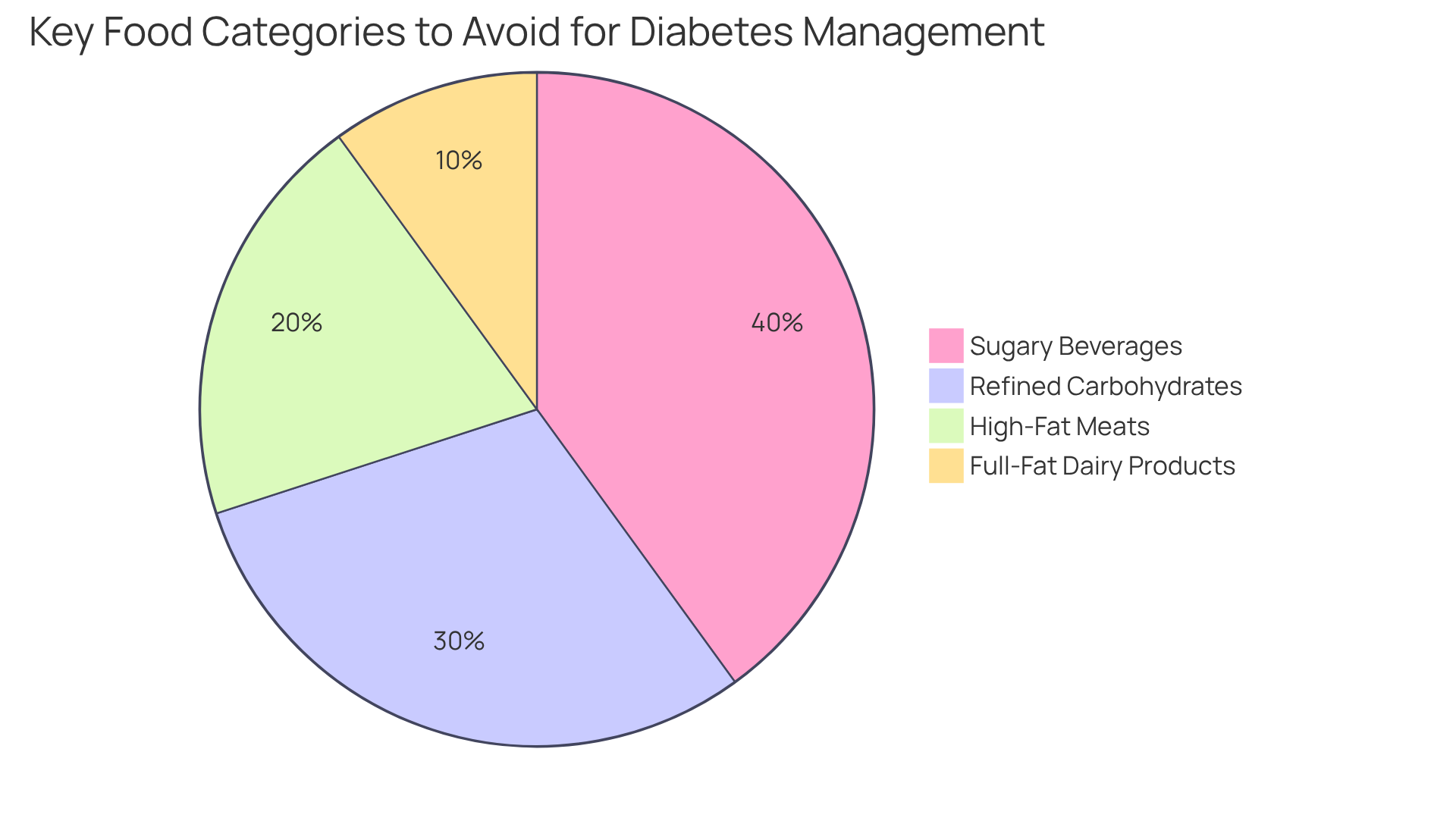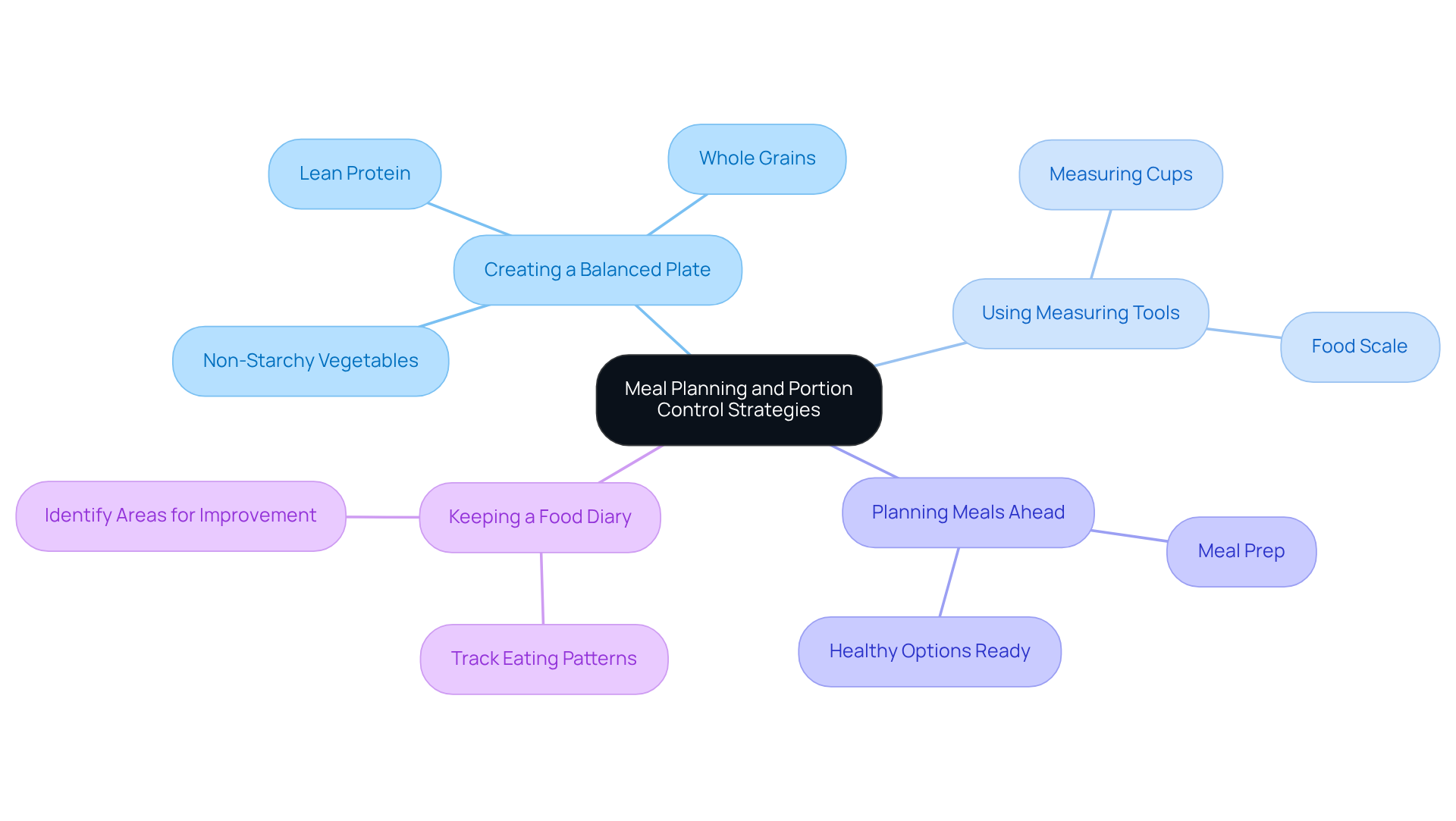Overview
Managing Type 2 diabetes can feel overwhelming, but understanding the essential foods can make a significant difference. High-fiber carbohydrates, lean proteins, healthy fats, and non-starchy vegetables are key components that help maintain stable blood glucose levels and promote overall health. It's important to remember that you're not alone in this journey; many have walked this path and found success through informed choices.
A balanced diet is crucial, and it goes hand-in-hand with careful monitoring of carbohydrate intake and thoughtful meal planning. These strategies are supported by evidence showing the benefits of specific food categories and dietary interventions. By taking these steps, you can empower yourself to manage your diabetes effectively.
If you’re feeling uncertain, know that there are resources and support available to help you navigate this journey. Consider reaching out to a nutritionist or joining a support group where you can share experiences and learn from others. Remember, we are here to support you every step of the way.
Introduction
Managing Type 2 Diabetes requires more than just medication; it demands a thoughtful approach to diet that can significantly influence blood sugar levels and overall health. It's understandable to feel overwhelmed by the information out there. By understanding which foods can enhance insulin sensitivity and which should be limited, you can take proactive steps toward better management of your condition. This journey can feel daunting, but you are not alone.
This article delves into essential foods, practical strategies, and critical dietary guidelines designed to empower you to make informed decisions for a healthier future. Together, we can navigate this complex landscape of dietary choices.
Understanding the Dietary Needs for Type 2 Diabetes
Managing Type 2 Diabetes involves understanding diabetes type 2 and what to eat to meet specific nutritional needs that are crucial for maintaining stable glucose levels and promoting overall wellness. To enhance insulin sensitivity and minimize the risk of diabetes-related complications, it is essential to know diabetes type 2 and what to eat as part of a balanced diet rich in essential nutrients. Let’s explore some important dietary considerations that can help you on this journey:
-
Monitoring Carbohydrate Intake: It’s important to keep an eye on your carbohydrate consumption. High carbohydrate diets can lead to spikes in blood sugar levels. For managing diabetes type 2 and what to eat, a moderate intake of ideally between 130-230 grams per day is recommended. When considering diabetes type 2 and what to eat, choosing high-fiber foods—like whole grains, fruits, vegetables, and legumes—can significantly improve glycemic control. Fiber is beneficial for diabetes type 2 and what to eat, as it helps slow down the processing of carbohydrates, leading to more stable glucose readings.
-
Ensuring Adequate Protein Consumption: Including enough protein in your meals can help you feel fuller longer and maintain muscle mass, which is particularly important for those managing diabetes. Understanding the glycemic index is essential for making informed choices about diabetes type 2 and what to eat. For those wondering about diabetes type 2 and what to eat, foods with a low GI have a lesser impact on blood sugar levels, making them preferable options.
Recent research highlights the positive impact of dietary interventions in managing Type 2 Diabetes. For example, studies indicate that a Mediterranean diet can significantly enhance glycemic control and insulin sensitivity compared to other dietary patterns. Nutritionists emphasize the importance of a well-rounded diet, specifically addressing diabetes type 2 and what to eat, tailored to your personal preferences and health goals. By focusing on these dietary strategies, particularly diabetes type 2 and what to eat, you can take proactive steps toward achieving better health outcomes and improving your quality of life.
Remember, you’re not alone in this journey. T2DSolutions is here to provide valuable resources and guidance as you navigate managing your diabetes through informed dietary choices. Together, we can work towards a healthier future.

Beneficial Food Categories for Type 2 Diabetes Management
If you're managing Type 2 Diabetes, understanding diabetes type 2 what to eat can include several food categories that can truly support your health and well-being. Let's explore these together:
-
Non-starchy vegetables: Leafy greens, broccoli, and bell peppers are not only low in calories and carbohydrates but also excellent for blood sugar control. Incorporating these vibrant vegetables into your meals can make a significant difference.
-
Whole grains: Foods like quinoa, brown rice, and whole-grain bread are packed with fiber and essential nutrients, helping to stabilize your glucose levels. Choosing whole grains can be a simple yet impactful step in your dietary journey.
-
Lean proteins: Sources such as chicken, fish, beans, and legumes are wonderful for promoting muscle health and keeping you feeling full, all without causing spikes in your glucose levels. These proteins can be a comforting addition to your meals.
-
Healthy fats: Avocados, nuts, and olive oil not only improve heart health but also provide you with sustained energy throughout the day. Including these healthy fats can be both nourishing and satisfying.
Incorporating these food categories into your daily meals can significantly enhance your understanding of diabetes type 2 what to eat for better management. Remember, you're not alone in this journey; we are here to support you every step of the way. Take small, manageable steps, and consider reaching out for resources or support that can help you thrive.

Foods to Limit or Avoid in a Type 2 Diabetes Diet
To sustain ideal glucose levels, it's essential to be mindful of diabetes type 2 what to eat that can impact your health. Here are some key items to consider avoiding:
-
Sugary beverages: Sodas, sweetened teas, and energy drinks can lead to rapid spikes in blood sugar, making them particularly challenging for diabetes management. In fact, sugary drinks accounted for about 4% of daily calorie intake in the U.S. during the 1970s, rising to around 9% by 2001. It's crucial to steer clear of these beverages to help maintain stable glucose levels. As Dr. Jan Hux, Chief Science Officer of the Canadian Diabetes Association, cautions, "Over the next 25 years, almost one million people will be diagnosed with type 2 diabetes as a result of sugary drink consumption."
-
Refined carbohydrates: Foods like white bread, pastries, and many processed snacks are low in fiber and can contribute to increased blood sugar levels. Diabetes educators often recommend choosing whole grains instead, which can be a healthier option.
-
High-fat meats: Fatty cuts and processed meats can elevate the risk of heart disease, a significant concern for those with diabetes. Reducing intake of these meats can help lower cardiovascular risks and promote better health.
-
Full-fat dairy products: Often high in saturated fats, these items may negatively affect heart health. Opting for low-fat or non-fat dairy options is advisable to support your overall well-being.
By being mindful of diabetes type 2 what to eat, you can better manage your diabetes and reduce the risk of complications. Many individuals who effectively avoid sugary drinks and processed carbohydrates often report improved glucose regulation and overall well-being. For example, studies have shown that implementing beverage restrictions in schools led to a significant decrease in household soda purchases, highlighting the effectiveness of limiting sugary drink availability.
Remember, you're not alone in this journey. By making informed choices, you can take proactive steps toward better health. We are here to support you every step of the way.

Meal Planning and Portion Control Strategies
Managing Type 2 Diabetes can feel overwhelming, but knowing diabetes type 2 what to eat along with effective meal planning and portion control can make a significant difference. Here are some compassionate strategies to help you navigate this journey:
- Creating a Balanced Plate: Picture your plate filled with vibrant, non-starchy vegetables taking up half the space. A quarter should be dedicated to lean protein, while the remaining quarter is for whole grains. This approach not only ensures you receive a variety of nutrients but also provides guidance on diabetes type 2 what to eat, helping you manage your sugar levels more effectively.
- Using Measuring Tools: It’s understandable that portion sizes can be tricky. Using measuring cups or a food scale can help you accurately gauge your servings. This simple practice can significantly reduce the risk of overeating, which is crucial for maintaining stable blood glucose levels.
- Planning Meals Ahead: Preparing meals in advance can be a lifesaver. It helps you resist the temptation of unhealthy choices when hunger strikes. By having nutritious options readily available, you empower yourself to make better dietary decisions about diabetes type 2 what to eat.
- Keeping a Food Diary: Tracking what you eat can illuminate your eating patterns and highlight areas for improvement. This self-monitoring is a powerful tool that enables you to make informed choices and adjust your diet as needed.
By incorporating these strategies into your routine, you can take charge of what to eat regarding diabetes type 2. Remember, you’re not alone in this journey; these steps can enhance your diabetes management and support your overall health. We are here to support you every step of the way.

Conclusion
Managing Type 2 Diabetes effectively hinges on understanding the critical role of nutrition in maintaining stable blood sugar levels and overall health. It’s understandable to feel overwhelmed by this journey, but by focusing on what to eat, you can make informed choices that enhance insulin sensitivity and reduce the risk of complications associated with diabetes. A well-rounded diet that includes essential foods while avoiding detrimental options can significantly improve your health outcomes.
Key dietary strategies include:
- Monitoring carbohydrate intake
- Prioritizing high-fiber and low-glycemic foods
- Ensuring adequate protein and healthy fats in your meals
- Emphasizing non-starchy vegetables, whole grains, lean proteins, and healthy fats to foster better glycemic control
- Being mindful of foods to limit or avoid—such as sugary beverages and refined carbohydrates—to further stabilize blood sugar levels
- Meal planning and portion control as vital components that empower you to make healthier choices consistently
Ultimately, the journey of managing Type 2 Diabetes through dietary choices is a shared experience. By adopting these strategies and seeking support, remember that you are not alone in this journey. Embracing a balanced diet not only aids in managing diabetes but also enhances your overall well-being, paving the way for a brighter future. We are here to support you every step of the way.
Frequently Asked Questions
What is the importance of understanding dietary needs for Type 2 Diabetes?
Understanding dietary needs for Type 2 Diabetes is crucial for managing glucose levels and promoting overall wellness. It helps enhance insulin sensitivity and minimizes the risk of diabetes-related complications.
How should carbohydrate intake be managed for Type 2 Diabetes?
It is important to monitor carbohydrate consumption, ideally keeping it between 130-230 grams per day. A moderate intake helps prevent spikes in blood sugar levels.
What types of foods are recommended for managing carbohydrate intake?
High-fiber foods such as whole grains, fruits, vegetables, and legumes are recommended as they can significantly improve glycemic control and help stabilize glucose readings.
Why is protein important in the diet for someone with Type 2 Diabetes?
Adequate protein consumption helps individuals feel fuller longer and maintain muscle mass, which is particularly important for those managing diabetes.
What is the glycemic index, and why is it relevant for Type 2 Diabetes?
The glycemic index (GI) measures how foods impact blood sugar levels. Foods with a low GI have a lesser impact on blood sugar, making them preferable options for managing diabetes.
What dietary pattern has shown positive effects on managing Type 2 Diabetes?
Recent research indicates that a Mediterranean diet can significantly enhance glycemic control and insulin sensitivity compared to other dietary patterns.
How can individuals tailor their diet for Type 2 Diabetes?
Nutritionists emphasize the importance of a well-rounded diet tailored to personal preferences and health goals to effectively manage Type 2 Diabetes.
Where can individuals find support for managing their diabetes through diet?
T2DSolutions provides valuable resources and guidance to help individuals navigate managing their diabetes through informed dietary choices.



